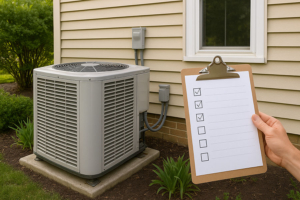Spring HVAC Maintenance Checklist: Prepare Your System for Warm Weather
 As spring approaches and temperatures begin to rise, it’s the perfect time to give your HVAC system a little TLC. After months of keeping your home warm during the winter, your system needs some attention to ensure it runs efficiently throughout the warmer months. A well-maintained HVAC system not only improves indoor comfort but can also help reduce energy bills and prevent costly repairs down the road.
As spring approaches and temperatures begin to rise, it’s the perfect time to give your HVAC system a little TLC. After months of keeping your home warm during the winter, your system needs some attention to ensure it runs efficiently throughout the warmer months. A well-maintained HVAC system not only improves indoor comfort but can also help reduce energy bills and prevent costly repairs down the road.
Follow this spring HVAC maintenance checklist to get your system ready for the heat and keep it running smoothly all season long.
1. Replace or Clean Your Air Filters
One of the simplest yet most important maintenance tasks is replacing or cleaning your air filters. Over time, filters collect dust, pet dander, and other airborne particles, restricting airflow and reducing efficiency.
- How often? Check your filter monthly and replace it every 1–3 months, depending on usage and whether you have pets or allergies.
- Why? A clean filter improves airflow, enhances indoor air quality, and helps your system operate more efficiently, saving you money on energy bills.
2. Clean and Inspect Your Air Ducts
Your air ducts distribute heated and cooled air throughout your home. If they’re clogged with dust and debris, your HVAC system has to work harder to maintain the desired temperature.
- How to check: Look for visible dust buildup around vents, weak airflow from registers, or an increase in allergy symptoms.
- What to do: Schedule a professional duct cleaning if you notice excessive dust, strange odors, or inconsistent airflow.
3. Check and Clear Outdoor AC Unit
Your outdoor unit (condenser) is exposed to the elements all year long, and debris like leaves, dirt, and twigs can accumulate around it. A blocked unit can reduce efficiency and cause overheating.
Steps to clean it:
- Turn off power to the unit.
- Remove any leaves, grass, or debris from around the system.
- Gently hose off the exterior fins to remove dirt buildup.
- Trim back any bushes or plants at least 2–3 feet away from the unit for proper airflow.
4. Inspect Refrigerant Levels
Your air conditioner relies on refrigerant to cool your home efficiently. If your system has a refrigerant leak, it won’t cool properly, and your energy bills may increase.
Signs of low refrigerant:
- Weak or warm airflow coming from vents
- Ice buildup on refrigerant lines
- Hissing sounds near the outdoor unit
What to do: If you suspect a refrigerant leak, contact an HVAC professional to inspect and recharge your system. Adding refrigerant without fixing a leak is only a temporary solution.
5. Test the Thermostat
A properly working thermostat ensures your HVAC system maintains comfortable indoor temperatures efficiently. If your thermostat isn’t working correctly, it can cause temperature fluctuations and increased energy usage.
How to test it:
- Set your thermostat to cooling mode and lower the temperature a few degrees.
- Listen for the system to turn on and feel for cool air from the vents.
- If it’s unresponsive, replace the batteries or consider upgrading to a smart thermostat for better energy savings.
6. Check and Clean Evaporator and Condenser Coils
Your AC system has two coils: the evaporator coil (inside your home) and the condenser coil (outside your home). Over time, these coils can collect dirt, which reduces efficiency and makes your system work harder.
How to clean:
- Turn off the system and access the coils (refer to your HVAC manual).
- Use a soft brush or vacuum with a brush attachment to remove dirt.
- For heavy buildup, contact an HVAC technician for professional cleaning.
7. Inspect and Clean Your Condensate Drain Line
Your air conditioner removes humidity from the air, and the condensate drain line carries that moisture away. If the drain gets clogged, it can lead to water damage, mold growth, and system failure.
Signs of a clogged drain line:
- Water pooling around your indoor unit
- Musty or moldy smells near vents
- AC shutting off unexpectedly
How to clean it:
- Locate the drain line (a PVC pipe near your indoor unit).
- Flush it with a mixture of warm water and vinegar to clear blockages.
- If the clog persists, call a professional to prevent further damage.
8. Schedule a Professional HVAC Tune-Up
While DIY maintenance is essential, a professional HVAC tune-up ensures your system is running at peak efficiency. A licensed technician will perform a thorough inspection, checking for potential issues before they turn into costly repairs.
What’s included in a professional tune-up?
- Checking electrical connections
- Lubricating moving parts
- Measuring refrigerant levels
- Testing system efficiency
- Inspecting blower components
Scheduling a professional service in early spring ensures your AC is ready for summer’s hottest days.
9. Seal and Insulate Your Home
Even the best HVAC system can’t work efficiently if your home has air leaks. Gaps around doors and windows let cool air escape, making your AC work harder.
Simple ways to improve insulation:
- Use weatherstripping around windows and doors.
- Add caulking to seal cracks and gaps.
- Insulate your attic and walls to maintain indoor temperatures.
10. Consider Upgrading an Older System
If your HVAC system is over 10–15 years old and struggling to keep your home cool, it may be time for an upgrade. New energy-efficient systems use less energy, cool your home faster, and save you money on utility bills.
Signs you may need a new system:
- Frequent repairs
- Rising energy bills
- Uneven cooling throughout your home
- Loud or unusual noises from the unit
A high-efficiency HVAC system can lower your energy consumption and provide better indoor comfort throughout the summer.
Final Thoughts
Spring is the perfect time to give your HVAC system the maintenance it needs before the heat sets in. By following this spring HVAC maintenance checklist, you’ll improve efficiency, extend the lifespan of your system, and keep your home comfortable all season long.
For professional HVAC maintenance, repairs, or system upgrades, contact Jacobs and Rhodes today! Our team of experts is ready to help you stay cool and save energy this summer.
Contents
- 1 1. Replace or Clean Your Air Filters
- 2 2. Clean and Inspect Your Air Ducts
- 3 3. Check and Clear Outdoor AC Unit
- 4 4. Inspect Refrigerant Levels
- 5 5. Test the Thermostat
- 6 6. Check and Clean Evaporator and Condenser Coils
- 7 7. Inspect and Clean Your Condensate Drain Line
- 8 8. Schedule a Professional HVAC Tune-Up
- 9 9. Seal and Insulate Your Home
- 10 10. Consider Upgrading an Older System
- 11 Final Thoughts


